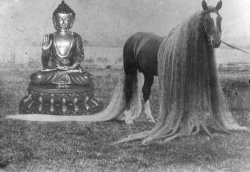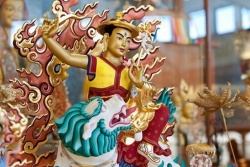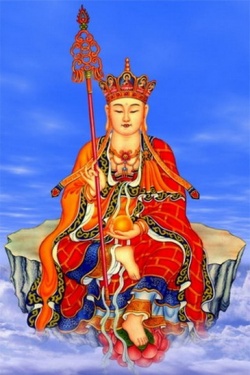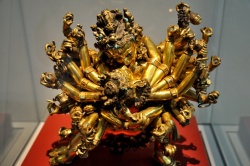Held by the Mother of the Buddhas: The Life of Shakyashribhadra
by Adrian O’Sullivan
Of the many great Indian panditas who undertook the trans-Himalayan journey to Tibet during the early and later phases of dharma transmissions, three masters stand out most notably – Shantirakshita, Atisha, and Shakyashribhadra. Shantirakshita was invited to the court of Trisong Detsun as guru to the king, and it was he who enabled Guru Padmasambhava to come to Tibet. He was the first truly great scholar to visit Tibet, bringing an ocean of dharma teachings there, and he introduced the precious vinaya for the first time in a lineage which remains to this day. Atisha’s importance is so well known, it need hardly be mentioned; it is sufficient to say that there was nobody in either India or Tibet who did not bow to the feet of that noble lord.
Shakyashribhadra (1127-1225), whose immense learning was incomparable even in India, who was head of the famed dharma universities of Vikramashila and Nalanda, and who was continually blessed with visions of the mother of the buddhas, Arya Tara, was the last of the great Indian panditas to visit Tibet. He is somehow less well-known to Westerners than his two predecessors, perhaps because, unlike them, he did not compose a major text of his own; yet his impact was immense. In Tibet, the name Shakyashribhadra, or Kha-che Panchen (‘the Mahapandita of Kashmir’), was known in the gompas of every tradition across the entire Himalayan plateau.
Shakyashri was born in Dasobhara in Kashmir, where he received a traditional Brahmin education. At the age of 23, he took novice ordination from one Sukhashribhadra-deva. Following a prophesy, he left for eastern India, the heartland of buddhadharma, where he studied widely, and received final monastic ordination at the age of 30 from Shantakaragupta. He had many visions of deities who spoke to him and made predictions, most notably Tara herself. Following his initiation in anuttara tantra, he saw directly the deities Chakrasamvara and Kalachakra. In Bihar and other places, he received innumerable dharma teachings, and became renowned as a truly great master. Having completely mastered all the ‘five sciences’ and thus becoming a mahapandita, he accepted abbacy of Nalanda and also Vikramashila, thus taking over the seat occupied by Atisha 150 years before. He also visited the great dharma college of Odantapuri, where he addressed an audience of twelve-thousand monks. He visited Varanasi and Bodhgaya, where he had visions of Shakyamuni, Chenrezik and Tara.
As the twelfth century turned into the thirteenth, Bihar and then Bengal became increasingly embattled as Turkic invaders extended their control in the east of India. Varanasi was overrun; Vikramashila was destroyed; the bhikshus of Odantapuri were slaughtered without exception before the invaders even realised it was a university. The mahapandita was forced to flee eastwards in very dangerous circumstances, but soon returned to Bihar to continue working for dharma despite the difficult conditions.
The great Tibetan master Trophu Lotsawa (b. 1173) had, by the age of 30, successfully brought the masters Mitrayogin and Buddhashri from India to Tibet, through whom many important teachings were introduced to the land of snows. Encouraged by predictions of certain lamas, including the elderly Lama Zhang of the Tshalpa Kagyu, Trophu Lo proceeded once more to India, intending to return with none other than the mahapandita.
He composed a letter in Sanskrit praising the mahapandita as the ‘crest jewel of all who have mastered the five sciences’ and requesting he come to Tibet. He sent this along with vast offerings and a delegation to the master, who, having received a premonition from Tara, was awaiting their arrival. However, some important sthaviras in the region assembled and implored Shakyashri to remain, bringing with them holy rupas of Chenrezik and Tara blessed by Arya Nagarjuna himself. The Tibetans employed the advice of Lama Zhang not to be ‘humble or irresolute’ in their mission and bribed the Kashmiri assistant in charge of images to turn them around so only their backs could be seen, this being a bad omen for Shakyashri’s remaining in India.
When Trophu Lotsawa arrived, Shakyashri was surprised at his young age, and was considering remaining in India, but on witnessing a debate between the young Lotsawa and Shakyashri’s entourage of junior panditas, the mahapandita decided to travel to Tibet.
Thus the mahapandita and his entourage travelled with Trophu Lo across the great Himalayas and pressed on through western Tibet towards Tsang. Word had spread far and wide of the arrival of a mahapandita, bringing thousands upon thousands of monks and laymen there to see him. At Trophu in western Tsang and other places in the region, Shakyashri taught many texts, including works on vinaya, abhidharma, prajnaparamita, madhyamaka, the works of Maitreya, and innumerable vajrayana teachings from the four tantra sets.
At Nyang, northeast of Sakya in Tsang, he was visited by the 23 year-old Khon lama and future ‘Sakya Pandita’, Kunga Gyaltsen, whose knowledge of Sanskrit greatly impressed the mahapandita. The descendants of Sachen had already inherited a vast ocean of dharma, unrivalled by other institutions, of which the foremost were the tantric teachings of the great lotsawas Bari, Drokmi and Mal. Through his studies with the mahapandita and the junior panditas, the young Khon’s learning was increased yet more with works of sutra, tantra and, importantly, classical secular subjects which were previously unknown in Tibet, brought from the now destroyed universities of India. Sapan returned to Sakya to continue his studies with Sugatasri, one of the learned assistant panditas.
The mahapandita continued to impart his wealth of sutra and tantra teachings. At the Kadampa monastery of Narthang, when a crow snatched some of the pages of the Prajnaparamita during a teaching and took them east towards the central Tibetan region of U, Shakyashri saw this as a sign from Tara indicating that he should proceed there. In U, he gave many teachings at the great monastic centres of Lhasa, Srinpori, Samye and also Tshurphu, which latter institution has been founded just twenty years prior, late in the life of the first Karmapa. During these years, the mahapandita made many new translations of texts and ordained many monks.
Whilst at Samye, he discovered a Sanskrit original of the ancient tantra, the Guhyagharba . Just as Atisha had during his visit to Samye, Shakyashri lent his personal authority to the authenticity of Nyingma tantras. This also set an auspicious precedent for Sakya Pandita’s later discovery of fragments of the Vajrakila tantra there, which would be important for establishing the authenticity of the Khon Vajrakila system. Indeed, Shakyashri added his support for the authenticity of the Vajrakila teachings by bearing personal witness to their existence in India.
In 1207, while staying at Thangpoche monastery, the mahapandita established a new Buddhist chronology. This differed considerably from previous Tibetan chronologies, and its dates for the lifetime of Shakyamuni Buddha have proven much closer to modern estimates than the other systems.
After approximately four years in U, the mahapandita returned to Tsang, where Sakya Pandita visited him again. The Sakya throne had been held by Jetsun Drakpa Gyaltsen since Sapan’s birth, and the latter requested permission from Drakpa Gyaltsen to take full ordination from the Kashmiri Vinayadhara. Sapan took the final vows at the age of 27. Sakya Trizin Drakpa Gyaltsen ordered Sapan to maintain the vows flawlessly, and it is said that from receiving them to the end of his life, Sapan did not incur even the slightest infringement. Thus it was Shakyashri’s ‘Kashmiri system’ ( kha che lugs ) of vinaya that entered Sakya, and this system would become the greatest of the three vinaya lineages in Tibet, being adopted by all the ‘new’ ( gsar ma ) tantra traditions. Many important early masters of the various Kagyu schools were ordained by the mahapandita himself, and the Gyalwa Karmapas too were ordained through this prestigious lineage in due course. This also being the lineage into which Tsongkhapa, founder of the Gelug order, was ordained, it became pre-eminent in that illustrious tradition. Shakyashri also founded four major monastic centres, the ‘Four Assemblies’ ( tshogs bzhi ), in U and Tsang.
During his earlier time with the mahapandita, Sakya Pandita had studied extensively the great Indian work on logic, Pramanavartika , with Pandita Dhanashila, and now together with Khache Panchen, the two mahapanditas made a new translation, with numerous corrections to the earlier versions. Utterly mastering this subject, it is said that Sapan refuted all who were not in possession of the pure teaching. Later, Sapan would compose the monumental tshad ma rig gter , the most definitive and influential Tibetan work on logic.
Sapan’s now unparalleled learning positioned Sakya to become the pre-eminent centre of scholasticism in Tibet, surpassing even the great monastic university of Sangphu in mastery of the ‘five sciences’. Being the era just before the apotheosis of Sakya power and influence in Tibet under the fifth patriach, Chogyal Phakpa, the impact for Tibetan secular and religious history of the relationship between Kha-che Panchen and Sakya Panchen cannot be overstated.
Trophu Lotsawa had been carrying out a project to erect an enormous statue of Maitreya at Trophu, and in 1212, Shakyashri contributed greatly to its funding, as well as engaging on a wide fundraising tour in support of this, necessitating a second journey around U. Finally, when the rupa was complete, he consecrated it in a great ceremony as his last major deed in Tibet. Although many lamas begged him to stay, he was resolved to follow a prediction by Tara that he should return to Kashmir.
In 1214, after ten years in Tibet, he set out on the road back through Gungtang and Ngari in the west of Tibet. Before departing Tibet, he donated his considerable remaining gold to the astounded Trophu Lotsawa who had accompanied him that far. After a long but unmolested journey across the Himalayas by the now very aged mahapandita, he arrived back in the luscious valley of his Kashmiri homeland, not seen since his youth. There, he restored many viharas and greatly increased the teachings, as the sun of dharma was setting on the country of the Aryas. Shakyashribhadra passed into nirvana in 1225. His life was one of remarkable accomplishments, and great historical significance. For the fortunate followers of Shri Sakya, the blessings of Shakyshribhadra endure in the precious jenangs and sadhanas held by contemporary Sakya masters.
References
Jackson, David P., (trans.) 1990. Two Biographies of Sakyasribhadra: The Eulogy of Khro phu Lo tsa ba and its Commentary by Bsod nams Dpal Bzang po. Franz Steiner Verlag Stuttgart
Stearns, Cyrus, (trans.) 2001. Luminous Lives: The Story of the Early Masters of the Lam ‘Bras Tradition in Tibet. Wisdom Publications
Roerich, George N., trans. (1959 ). The Blue Annals. Delhi: Motilal Banarsidas
Obermiller E., trans. (1932). History of Buddhism by Buston . Heidelberg




